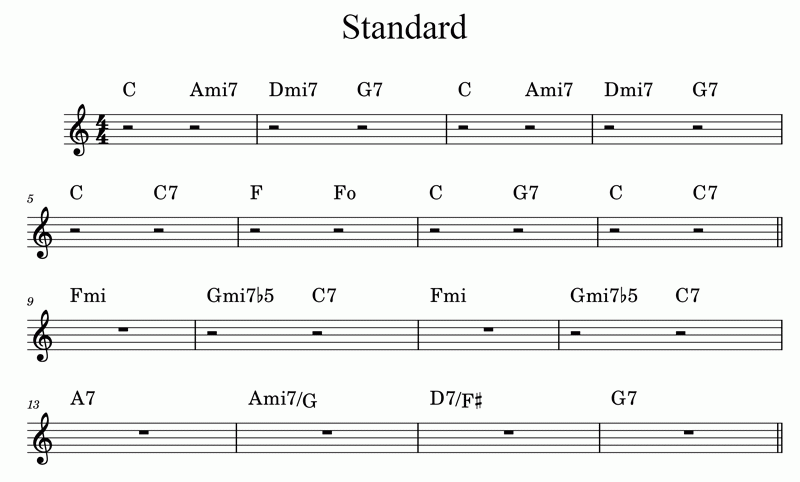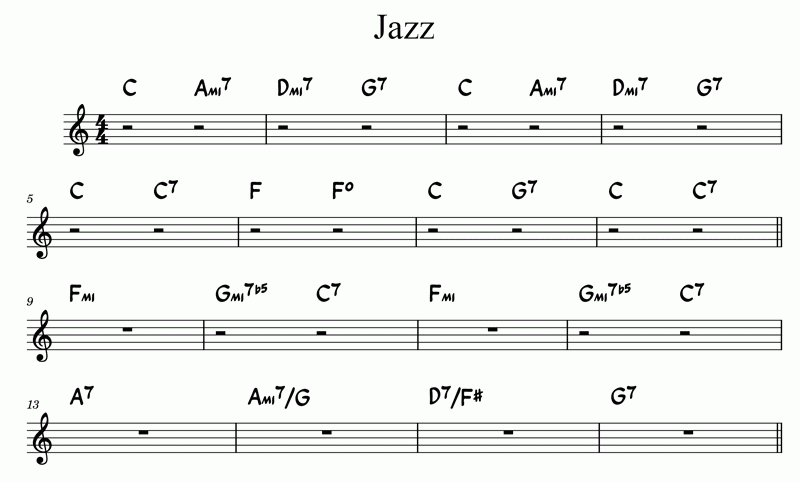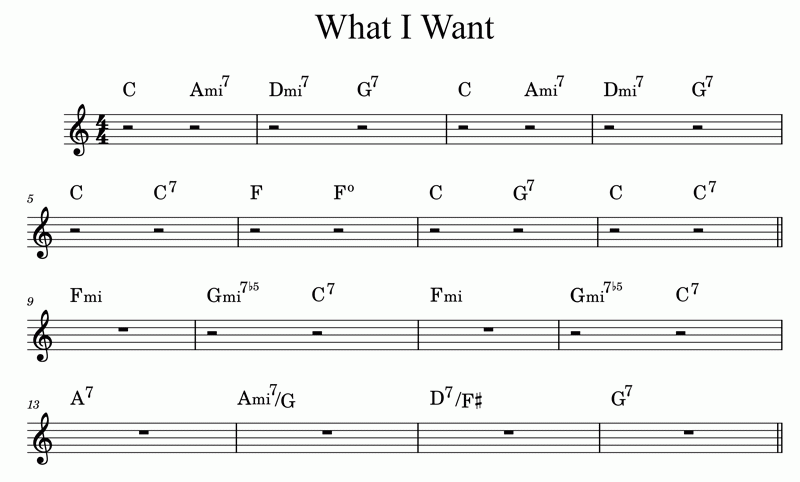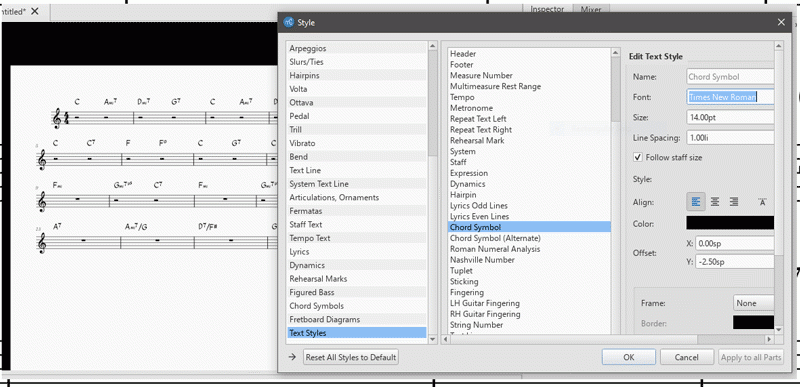Circle symbol for diminished chord?
I have been trying to get the superscript circle (like a degree sign) in my lead sheets. Up until the last couple of updates, I used a standard degree sign. I could even copy & paste it, and it worked. Now, that results in an underlined superscript circle; not the result I want. I have searched the manual, the forums, youtube, web searches, all to no avail. I do not want to use ’dim’, as it takes up too much room; just want the small elevated o. Using version 3.3.4.... the most recent update on my Mac. Please help.
Comments
I use o (lowercase letter o) for diminished and 0 (number zero) for half-diminished (m7b5) and Jazz style. Musescore renders that correctly
Correct - lower case "o" for diminished, number "0" for half-diminished are automatically understood by MuseScore, no need for inserting symbols manually. How MuseScore renders the symbol depends on your chord symbol style settings (see Format / Style Chord Symbols) - standard vs, jazz, also the new superscripting settings.
Although using the degree sign intended for chord symbols - the one you can find in the Special Characters palette - should work as well. As should the old-style Unicode one. Not sure where you are getting yours from?
Feel free to attach your score if you continue to have problems.
In reply to Correct - lower case "o" … by Marc Sabatella
I had tried each of the degree sign methods you mention, but I used only the Standard font, and the diminished circle stays in line with the Chord, rather than superscript, no matter what. Changing the chords to Jazz worked.
I don’t see the new superscripting setting that you mention.
I use MuseScore exclusively to enter existing scores so that I can simplify chords, transpose music, change music from full scores to simple lead sheets, or enter music from old jazz fakebooks that are sometimes almost impossible to read. My main goal is usually to get a tune on one page with the chords large enough for older eyes to follow.
Now, if I could just change your very impressive manual‘s index so that I could look things up without knowing the correct musical terminology. I do lots of page by page searching, and trial & error use, and eventually find what I need.
Thank you all for your help on this one where the solution wasn’t in the manual.
In reply to I had tried each of the… by bevanderson
Superscript option is right there in the same dialog where you select the Jazz style - "Extension vertical offset". Although actually, "extension" is only supposed to affect numbers after the "o" or "m" (eg, the 7 in Co7"). Eventually there should maybe be a separate setting for the "quality".
Still, if you're dealing with jazz anyhow, might as well just use the jazz style. Better yet, use the Jazz Lead Sheet template, which sets up this and a bunch of other settings.
In reply to Superscript option is right… by Marc Sabatella
“Extension vertical offset,” really? That is, exactly, an example of why I find MuseScore difficult o use sometimes. Why isn’t it just called “Superscript”? There are so many places where what something is called in MuseScore isn’t what one looks for in “real life.” It might be a case of ‘music major’ terminology versus ‘stumbling around with music’ terminology, but a common English Glossary would be handy. Maybe in a future manual?
I’ll try using Jazz style for my next lead sheet to check out the difference. Thanks.
In reply to “Extension vertical offset,”… by bevanderson
Well, superscript isn’t specific enough - that’s why there are four separate settings in that section. First, there are separate settings for extensions versus modifiers, so at the very last there would need to be “extension superscript” vs “modifier superscript”. But, superscripting consists of two components - making the thing smaller, and making it higher. MuseScore is giving the ability to control both of those independently - how much smaller, and how much higher. So we need two different setting for that. And the term “superscript” is never used that way - it always is used as just a yes/no thing. Sure we could have taken away control and just decided for toy how much smaller and how much higher, but we know most people want to be in control.
So, that’s why there are four separate parameters, each of which labeled according to its specific function. The word “superscript “ would only have made sense as a label if it were not so customizable, but the results would not have been as satisfactory.
In reply to Well, superscript isn’t… by Marc Sabatella
Wow! What a lot you have put into this for those who want that kind of control!
How ‘bout for the rest of us, naming things in the manual, something like this. Superscript >Adding Superscript, then > “Look at this, wherever that extension modifier is, and then how to make it higher, lower, larger, or smaller.” This would also be helpful for things like how to control how many measures in a system, (see, I have learned a bit of your music terminology) and how to correctly stretch or tighten to force line breaks to get the look needed for single page tunes.
If you need a guinea pig for your “Manual for Dummies,” I’m your gal.
In reply to Wow! What a lot you have put… by bevanderson
Thanks for the suggestion! The feature is brand new - only added for 3.3 - so it hasn't been fully documented yet. But - the Handbook, like MuseScore itself - is open source. Feel free to click the Edit button (in the menu at top right of the page) and edit the page to read more as you'd like.
In reply to Wow! What a lot you have put… by bevanderson
Hey, dream bigger. {grin} If people like the chords.xml file I've been working on, at some point in the future you'll have another option for formatting chord symbols. "O Default O Superscript O Jazz O Custom". If you'd like to test-drive it, search for "superscript" in this forum.
In reply to Well, superscript isn’t… by Marc Sabatella
If you switch off of "Jazz" the "o" and "0" superscript characters do not appear to be counted as either "Extensions" or "Modifiers".
In reply to Correct - lower case "o" … by Marc Sabatella
Thanks.. I had to change my chord style settings to Jazz (which I wanted) to get the half diminished symbol to appear when I typed 0 (zero).. thanks solved my issue
In reply to Correct - lower case "o" … by Marc Sabatella
Is there any way for the font face to remain in the standard setting even though I use the jazz setting? I just really want the diminish circle without changing the font face. It doesn't fit the score Im trying to transcribe. Thanks in advance
In reply to Is there any way for the… by giandeleon21
Although the Jazz style does use the Jazz font, it isn't a matter of font face, but of chord symbols style.
In reply to Is there any way for the… by giandeleon21
To get diminished in any style, just type "o". It renders differently in different styles - more circular in the jazz style, more like the letter "o" in standard styles. I guess you are saying, you want the more circular "o" even though not using the jazz style? This isn't commonly done - most publishers outside the jazz world (and many inside it) simply write out "dim" - but if you need the circle for some reason, you can create a custom chord description XML file. This process isn't exactly documented or supported but does work. If you search these forums for the phrase "chord description XML file" you'll find some discussion of this.
In reply to Is there any way for the… by giandeleon21
Yeah I think this is similar to this other thread (https://musescore.org/en/node/298614) and it overall seems to be a confusion/lack in the difference between "Standard" and "Jazz" chord symbol rendering. I think in general it would be great to be able to choose "Jazz" style without "Jazz" font, and still choose a custom font from the UI even when selecting "Jazz" style.
I've attached examples below (thanks to Photoshop). Note the use of Edwin font, but with some differences borrowed from the "Jazz" style: "mi" is smaller, "7" is smaller and raised, "b5" is smaller and raised, and the diminished circle is smaller and raised (similar to a degree symbol).



I think it's odd/unexpected that a user could change the font for chord symbols in the UI, but it will have no visible effect if the "Jazz" style is selected on another screen.

In reply to Yeah I think this is similar… by Alex Burr
Based on the other thread, it's possible to get this with custom XML, but this is non-intuitive and has to be set every time.
In reply to Based on the other thread,… by Alex Burr
Well, not every time if you make it into a template. But anyhow, yes you can just about anything you want that way. Eventually we do hope to provide more controls, and work has begun on that for inclusion i a future release (not 4.0, but hopefully something not long after).
In reply to Yeah I think this is similar… by Alex Burr
The reason the jazz style is hardcoded to MuseJazz font is that it completely relies on a lot of non-standard custom glyphs in that font. It just wouldn't work with any other.